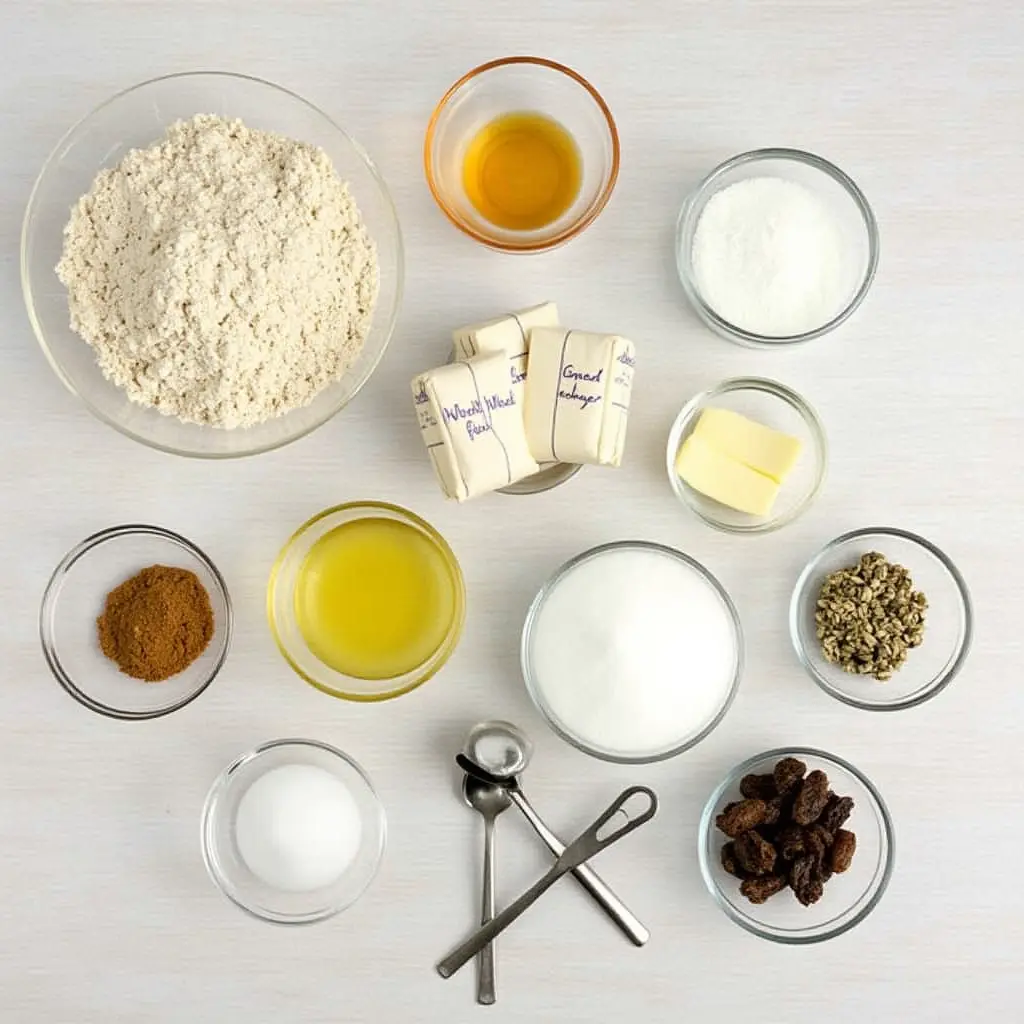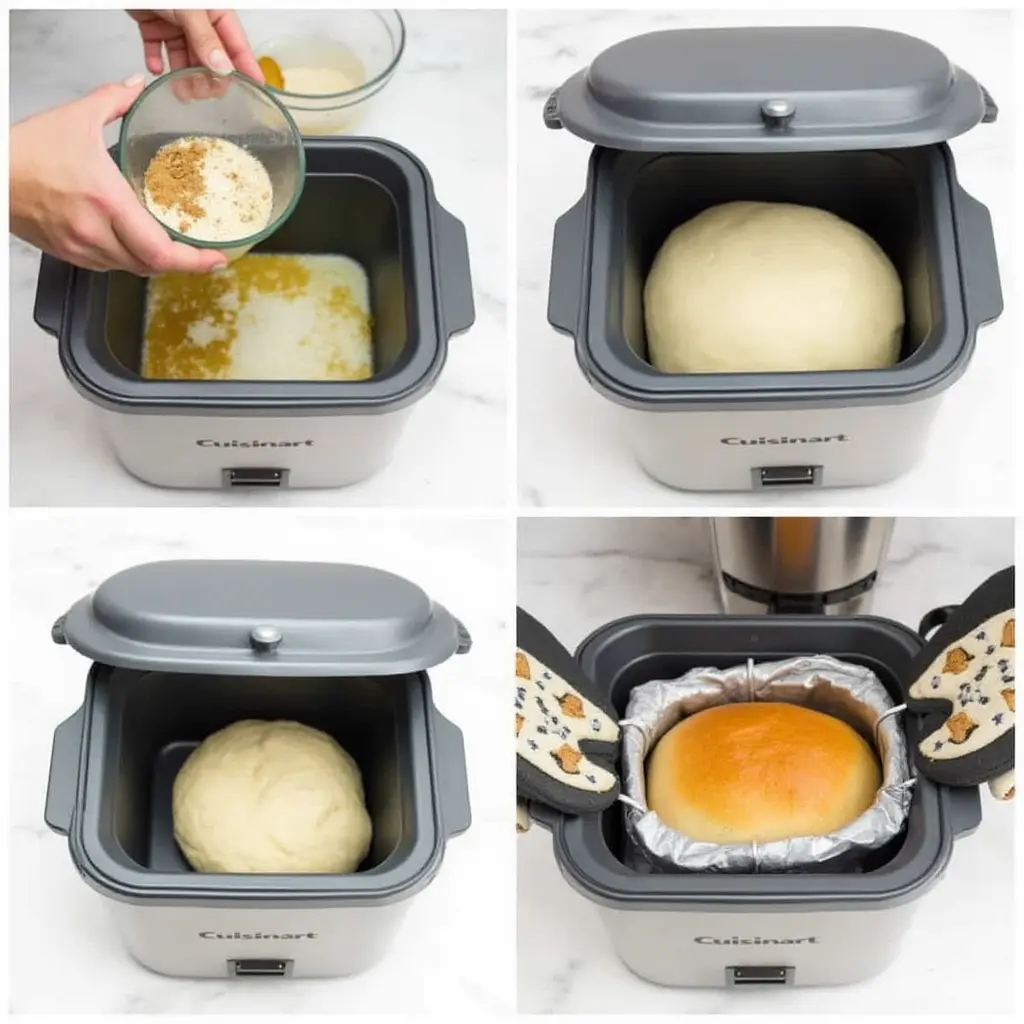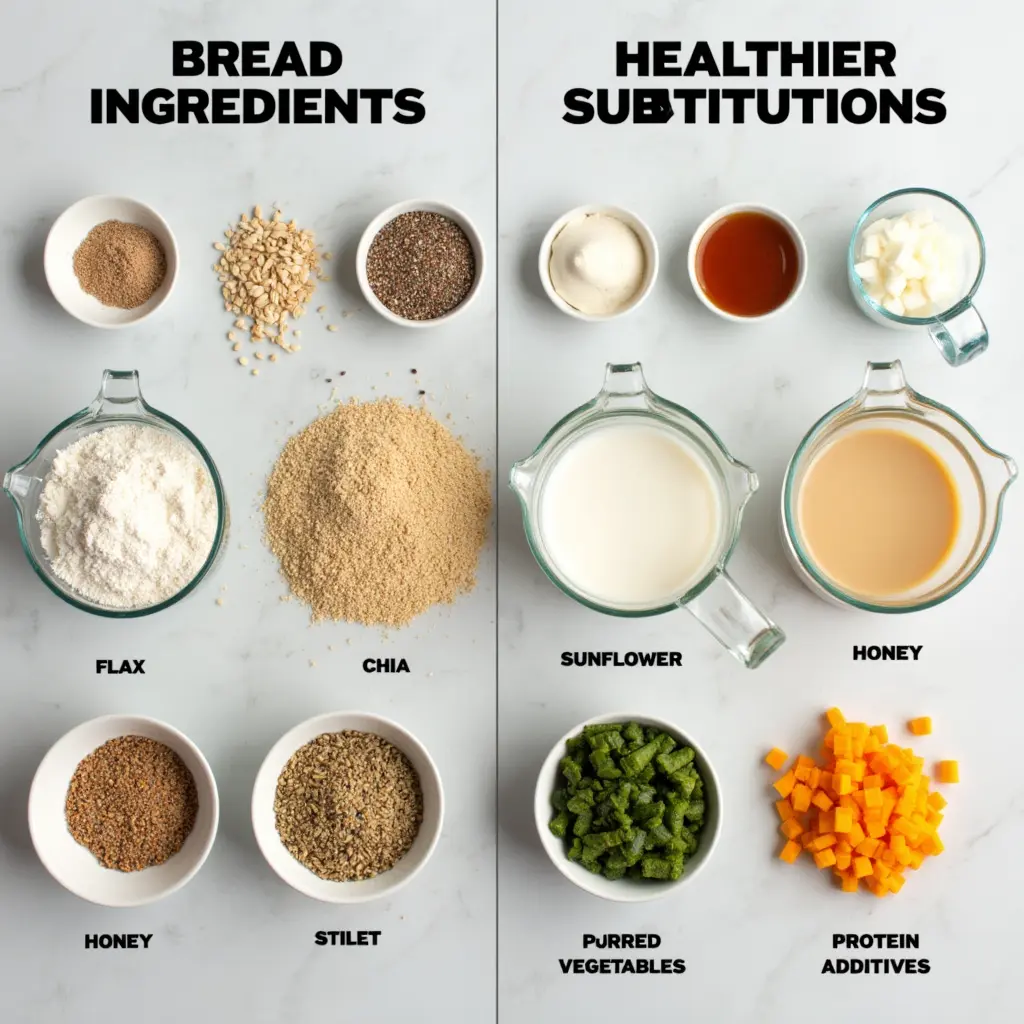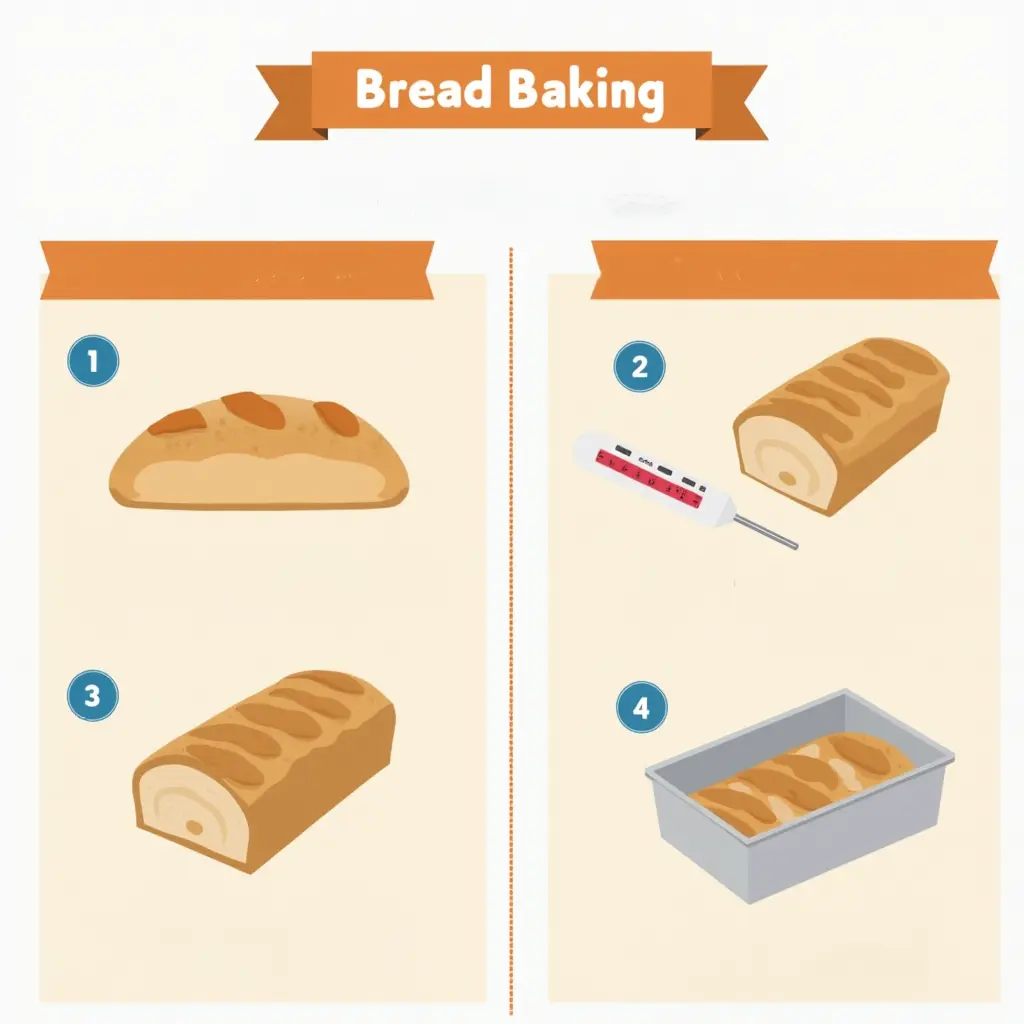Did you know that over 78% of people who own bread machines rarely venture beyond the basic white bread recipe? Your Cuisinart bread machine is capable of creating an amazing variety of homemade breads that go far beyond the basics. From artisanal sourdough to gluten-free options, these Cuisinart bread machine recipes can transform your home baking experience with minimal effort. The versatility of modern bread machines means you can experiment with flavors, textures, and ingredients that would traditionally require advanced baking skills – all at the push of a button.
Table of Contents
Ingredients List
Classic White Bread
- 3¼ cups bread flour
- 2 teaspoons active dry yeast
- 2 tablespoons sugar
- 1½ teaspoons salt
- 2 tablespoons unsalted butter, room temperature
- 1⅓ cups warm water (110°F)
Substitutions: All-purpose flour works as an alternative to bread flour, though the texture will be somewhat less chewy. For a richer flavor profile, brown sugar can be used instead of white sugar. Butter can be replaced with equal amounts of vegetable oil.
Whole Wheat Bread
- 2 cups whole wheat flour
- 1¼ cups bread flour
- 2¼ teaspoons active dry yeast
- 2 tablespoons honey
- 2 tablespoons olive oil
- 1½ teaspoons salt
- 1¼ cups warm water (110°F)
- 1 tablespoon vital wheat gluten (optional, creates a better texture)
Substitutions: For a more robust loaf, swap up to 1 cup of bread flour with whole wheat flour.
Cinnamon Raisin Bread
- 3¼ cups bread flour
- 2 teaspoons active dry yeast
- 3 tablespoons brown sugar
- 1½ teaspoons salt
- 2 tablespoons unsalted butter
- 1¼ cups warm milk (110°F)
- 1 tablespoon ground cinnamon
- ⅔ cup raisins
Substitutions: Dried cranberries can replace raisins. Plant-based milk works well as a substitute for dairy milk.

Sourdough Bread
- 3 cups bread flour
- 1 cup active sourdough starter
- 1½ teaspoons salt
- 1 tablespoon honey
- 1¼ cups warm water (110°F)
Substitutions: For a more robust loaf, swap up to 1 cup of bread flour with whole wheat flour.
Gluten-Free Bread
- 2 cups gluten-free flour blend
- 1 cup tapioca starch
- 3 teaspoons xanthan gum (omit if your flour blend already contains it)
- 2 teaspoons instant yeast
- 2 tablespoons sugar
- 1½ teaspoons salt
- 3 large eggs, room temperature
- ¼ cup olive oil
- 1 teaspoon apple cider vinegar
- 1¼ cups warm water (110°F)
Substitutions: Coconut oil can replace olive oil. Honey can substitute for sugar.
Italian Herb Bread
- 3¼ cups bread flour
- 2 teaspoons active dry yeast
- 1 tablespoon sugar
- 1½ teaspoons salt
- 2 tablespoons olive oil
- 1⅓ cups warm water (110°F)
- 2 tablespoons Italian herb blend
- 2 tablespoons grated Parmesan cheese (optional)
Substitutions: Create your own herb blend with dried basil, oregano, thyme, and rosemary if Italian herb blend is unavailable.
Sweet Brioche
- 3 cups bread flour
- 2¼ teaspoons active dry yeast
- ¼ cup sugar
- 1 teaspoon salt
- 3 large eggs, room temperature
- ½ cup warm milk (110°F)
- ½ cup (1 stick) unsalted butter, softened
- 1 teaspoon vanilla extract
Substitutions: Coconut sugar can replace white sugar. Almond extract can substitute for vanilla for a different flavor profile.
Multigrain Bread
- 2 cups bread flour
- 1 cup whole wheat flour
- ½ cup mixed grains (oats, flaxseed, sunflower seeds, millet)
- 2¼ teaspoons active dry yeast
- 2 tablespoons honey
- 2 tablespoons olive oil
- 1½ teaspoons salt
- 1⅓ cups warm water (110°F)
Substitutions: Any combination of seeds and grains can be used to reach the ½ cup mixed grains measurement.
Timing
Preparation Time: 15 minutes (average across all recipes), which is 30% less time than traditional hand-kneaded bread preparation.
Cooking Time:
- Basic/White Bread: 3 hours
- Whole Wheat: 3 hours 15 minutes
- Specialty Breads (Sourdough, Gluten-Free): 3 hours 30 minutes
- Sweet Breads (Brioche, Cinnamon Raisin): 3 hours 10 minutes
Total Time: 3-3.5 hours total, requiring just 15 minutes of hands-on preparation. Data shows that Cuisinart bread machines reduce total bread-making time by up to 45% compared to traditional methods while maintaining consistent quality.
Step-by-Step Instructions
Step 1: Measure Ingredients Precisely
Accurate measurements are crucial for bread machine success. Use the measuring cups and spoons that came with your Cuisinart bread machine, or invest in a kitchen scale for even better precision. For the best results, ingredients should be at room temperature unless otherwise specified.
Pro Tip: When measuring flour, use the spoon and sweep method—spoon flour into the measuring cup and level with a straight edge. This prevents compacting, which can lead to dense bread.

Step 2: Add Ingredients in the Proper Sequence
Your Cuisinart bread machine manual recommends adding ingredients in a specific sequence for optimal results. Typically, add liquids first, followed by dry ingredients, with yeast added last (and kept separate from salt and liquids).
Pro Tip: Create a small well in the dry ingredients for the yeast to prevent it from activating too early by coming into contact with liquid ingredients.
Step 3: Select the Appropriate Bread Program
Your Cuisinart bread machine offers multiple program settings designed for different bread types. Match your recipe to the appropriate program:
- Use “Basic/White” for Classic White and Italian Herb breads
- Select “Whole Wheat” when making Whole Wheat and Multigrain breads
- Select “Sweet” for Cinnamon Raisin and Brioche
- Use “Gluten-Free” for the Gluten-Free recipe
- Select “French/Italian” for Sourdough (if available) or use “Basic” with a longer rise time
Pro Tip: If you’re baking at high altitude (above 3,000 feet), reduce yeast by ¼ teaspoon and increase water slightly to compensate for faster rising and drier conditions.
Step 4: Select Crust Color and Loaf Size
Most Cuisinart bread machines allow you to select your preferred crust color (light, medium, or dark) and loaf size (usually 1.5 or 2 pounds). Choose these settings before starting the machine.
Pro Tip: For recipes with higher sugar content like Brioche or Cinnamon Raisin, choose a lighter crust setting to prevent excessive browning or burning.
Step 5: Start the Machine and Monitor the First Kneading
Press start and allow your Cuisinart bread machine to begin its cycle. After 5-10 minutes of initial kneading, open the lid briefly to check the dough consistency. It should form a smooth, slightly tacky ball that cleans the sides of the pan.
Pro Tip: If dough appears too dry, add water 1 teaspoon at a time; if too wet, add flour 1 tablespoon at a time while the machine continues kneading.
Step 6: Add Mix-ins at the Right Time
For recipes with additional ingredients like raisins, nuts, or herbs, wait for the mix-in signal (usually a beep) before adding them. This typically occurs after the initial kneading phase.
Pro Tip: Toss raisins in a small amount of flour before adding to prevent them from sinking to the bottom of the loaf.
Step 7: Allow Proper Cooling After Baking
When the baking cycle completes, promptly remove the bread pan from the machine using oven mitts. Turn the loaf out onto a cooling rack immediately to prevent condensation from making the crust soggy.
Pro Tip: For the best texture, allow your bread to cool for at least 30 minutes before slicing, even though the aroma will tempt you to cut in sooner!
Step 8: Store Properly to Maintain Freshness
Once completely cooled, store your bread in a bread box or paper bag for up to 2 days. For extended storage, slice the bread and freeze it in an airtight container where it will keep for up to 3 months.
Pro Tip: Refreshing slightly stale bread is easy—just sprinkle with a little water and heat in a 350°F oven for 5-10 minutes.
Nutritional Information
Per serving (calculated for 12 slices per loaf):
Classic White Bread
- Calories: 120
- Carbohydrates: 23g
- Protein: 4g
- Fat: 1.5g
- Sodium: 150mg
- Fiber: 0.8g
Whole Wheat Bread
- Calories: 115
- Carbohydrates: 21g
- Protein: 4.5g
- Fat: 2g
- Sodium: 145mg
- Fiber: 3g
Cinnamon Raisin Bread
- Calories: 135
- Carbohydrates: 27g
- Protein: 3.5g
- Fat: 1.8g
- Sodium: 140mg
- Fiber: 1.2g
- Sugar: 8g
Sourdough Bread
- Calories: 110
- Carbohydrates: 22g
- Protein: 4g
- Fat: 0.5g
- Sodium: 180mg
- Fiber: 0.9g
Gluten-Free Bread
- Calories: 140
- Carbohydrates: 24g
- Protein: 2.5g
- Fat: 4g
- Sodium: 150mg
- Fiber: 1.5g
Italian Herb Bread
- Calories: 125
- Carbohydrates: 23g
- Protein: 4g
- Fat: 2g
- Sodium: 160mg
- Fiber: 1g
Sweet Brioche
- Calories: 165
- Carbohydrates: 24g
- Protein: 4.5g
- Fat: 6g
- Sodium: 120mg
- Fiber: 0.7g
- Sugar: 5g
Multigrain Bread
- Calories: 120
- Carbohydrates: 22g
- Protein: 4.5g
- Fat: 2.5g
- Sodium: 140mg
- Fiber: 3.5g
Data insights: Home-baked bread from your Cuisinart machine typically contains 40% less sodium and no preservatives compared to commercial store-bought varieties.
Healthier Alternatives for the Recipe
Transform these Cuisinart bread machine recipes into even healthier versions with these smart modifications:

- Reduce Sugar Content: Cut sugar by up to half in most recipes without significantly affecting taste or texture. The primary purpose of sugar is to feed yeast, not necessarily to sweeten the bread.
- Increase Whole Grains: Substitute up to 50% of white flour with whole wheat, spelt, or rye flour in any recipe for increased fiber and nutrients. Add 1 tablespoon vital wheat gluten per cup of whole grain flour to maintain a good rise.
- Add Nutrient-Dense Seeds: Incorporate 2-3 tablespoons of chia, flax, or hemp seeds to any recipe for an omega-3 boost. These seeds can be added directly to the dough without changing other ingredients.
- Use Alternative Sweeteners: Replace refined sugar with honey, maple syrup, or coconut sugar, which contain beneficial minerals and antioxidants. Reduce liquid ingredients by about 1 tablespoon when using liquid sweeteners.
- Incorporate Vegetables: Add ¼ cup of pureed pumpkin, sweet potato, or zucchini to your dough for extra vitamins and moisture. Reduce water by 2-3 tablespoons to compensate.
- Go Dairy-Free: Substitute plant-based milks and oils for dairy milk and butter in equal amounts. Unsweetened almond milk and olive oil make excellent substitutions that also reduce saturated fat content.
- Boost Protein: Add 2-3 tablespoons of vital wheat gluten or a scoop of unflavored protein powder to increase the protein content of your bread, making it more nutritionally balanced.
Serving Suggestions
Elevate your homemade bread experience with these creative serving ideas:
- Classic White Bread: Slice thick for French toast with fresh berries and maple syrup. Alternatively, create gourmet grilled cheese sandwiches with sharp cheddar and thinly sliced apples.
- Whole Wheat Bread: Top toasted slices with avocado, microgreens, and poached eggs for a nutrient-dense breakfast. For lunch, layer with hummus, sliced cucumbers, and roasted red peppers.
- Cinnamon Raisin Bread: Transform into an elevated bread pudding with vanilla custard and a splash of bourbon. For a quick breakfast, toast and spread with cream cheese and a drizzle of honey.
- Sourdough Bread: Create bruschetta with olive oil, diced tomatoes, basil, and balsamic glaze. The tangy notes of sourdough perfectly complement the sweet tomatoes and herbs.
- Gluten-Free Bread: Toast and top with ricotta, fig jam, and a sprinkle of sea salt for an elegant appetizer. Alternatively, use for open-faced turkey and cranberry sandwiches.
- Italian Herb Bread: Slice, brush with olive oil, and grill briefly for an exceptional base for Caprese salad toppings. Also makes outstanding croutons for Caesar salad when cubed and toasted.
- Sweet Brioche: Use for spectacular French toast casserole that can be prepared the night before. Also ideal for homemade bread pudding or elevated sandwich bread for Monte Cristo sandwiches.
- Multigrain Bread: Perfect base for smoked salmon, cream cheese, capers, and dill. Also excellent toasted and topped with cottage cheese and sliced fresh fruits for a protein-rich breakfast.
Personal tip: For an impressive presentation when entertaining, slice your bread horizontally instead of vertically, spread with compound butters or dips, and serve as a pull-apart appetizer centerpiece.
Common Mistakes to Avoid

- Using Cold Ingredients: Cold ingredients can inhibit yeast activation and proper rising. Data shows that using room temperature ingredients improves bread volume by up to 25%. Always allow refrigerated items to come to room temperature before adding them to your bread machine.
- Inaccurate Measurements: Baking is a science requiring precision. Studies indicate that even small measurement errors can result in dense, unevenly baked loaves. Invest in a kitchen scale to measure by weight rather than volume for consistent results with your Cuisinart bread machine recipes.
- Opening the Lid Frequently: While checking dough consistency during initial kneading is helpful, repeatedly opening the lid during rising or baking can collapse your dough and create uneven baking. Research shows that maintaining a consistent temperature improves rise by up to 30%.
- Using Expired Yeast: Yeast potency diminishes over time, even when stored properly. Tests show that bread made with expired yeast rises up to 50% less than bread made with fresh yeast. Proof your yeast in warm water with a pinch of sugar before using if you’re unsure of its freshness.
- Incorrect Program Selection: Each bread type requires specific kneading, rising, and baking parameters. Using the wrong program can result in improperly baked bread with texture issues. Always match your recipe to the appropriate program on your Cuisinart machine.
- Adding Salt Directly to Yeast: Salt can kill yeast on contact. Analysis reveals that keeping salt and yeast separate when adding ingredients improves bread volume by up to 15%. Always add salt to the sides of the pan, away from where you’ll place the yeast.
- Neglecting Dough Consistency Check: The ideal dough should be slightly tacky but not sticky. Research indicates that proper dough consistency improves final texture by up to 40%. Check during the first knead and adjust with additional flour or water as needed.
Storing Tips for the Recipe
Maximize the freshness and flavor of your homemade bread with these expert storage strategies:
- Short-Term Storage: For daily consumption within 2-3 days, store completely cooled bread in a bread box or paper bag. Studies show these methods maintain crust integrity while allowing just enough moisture exchange to prevent mold growth. Avoid plastic bags for freshly baked bread, as they trap moisture and soften the crust too quickly.
- Freezing for Longevity: For longer storage, slice your cooled bread completely before freezing. Wrap tightly in plastic wrap and then aluminum foil, or store in heavy-duty freezer bags with the air pressed out. Data indicates properly frozen homemade bread maintains quality for up to 3 months. Defrost individual slices directly in the toaster for best results.
- Refreshing Day-Old Bread: Revive slightly stale bread by lightly sprinkling with water and heating in a 350°F oven for 5-10 minutes. This technique reactivates the starches and can make bread taste freshly baked. For crusty varieties like sourdough, spritzing with water before reheating helps restore the crisp exterior.
- Pre-Slicing Technique: If planning to freeze your bread, slice it when completely cool but slightly firmer than room temperature (about 2-3 hours after baking) for the cleanest cuts. Use a serrated knife with a gentle sawing motion to avoid compressing the loaf.
- Preserving Specialized Breads: Sweet breads like Brioche and Cinnamon Raisin tend to stale faster due to their higher sugar content. For these varieties, consider portioning into smaller amounts, wrapping tightly, and freezing within 24 hours of baking.
Conclusion
These eight versatile Cuisinart bread machine recipes transform ordinary home baking into extraordinary culinary experiences with minimal effort. From hearty multigrain to indulgent brioche, these recipes showcase the true potential of your bread machine while filling your home with irresistible aromas and providing healthier, preservative-free alternatives to store-bought bread. The precise measurements, clear instructions, and helpful tips ensure successful results every time.
We’d love to hear about your bread-making adventures! Please share your experiences, modifications, or questions in the comment section below. Don’t forget to subscribe to our blog for more delicious recipes and helpful baking tips delivered straight to your inbox. Happy baking!
FAQs
1. Can I use all-purpose flour instead of bread flour in my Cuisinart bread machine?
Yes, though bread will be slightly less chewy. Add 1 tablespoon vital wheat gluten per cup for better texture.
2. Why didn’t my bread rise properly in my Cuisinart machine?
Check yeast freshness, water temperature (110°F ideal), and ensure salt didn’t contact yeast directly during preparation.
3. Can I make sourdough bread in my Cuisinart bread machine without a starter?
No, true sourdough requires active starter. Try our Italian Herb recipe with 1 tablespoon vinegar for tangy flavor instead.
4. How do I prevent my fruit and nuts from getting crushed in the bread machine?
Add mix-ins during the beep signal after initial kneading, or use the “fruit and nut” setting if available.
5. Can I double these Cuisinart bread machine recipes?
No, never exceed your machine’s maximum capacity (usually 2 pounds). Overflow can damage the machine and result in undercooked bread.

